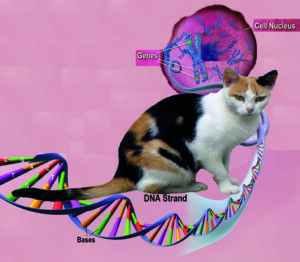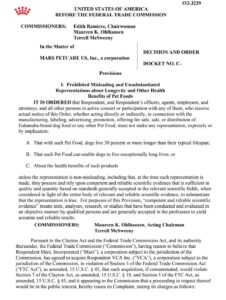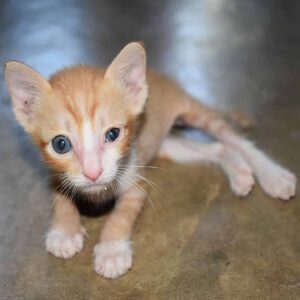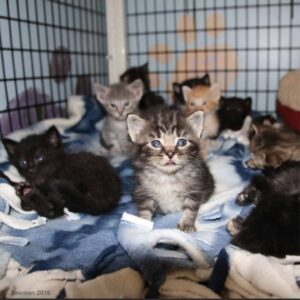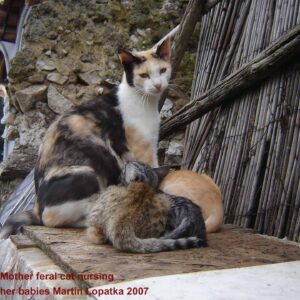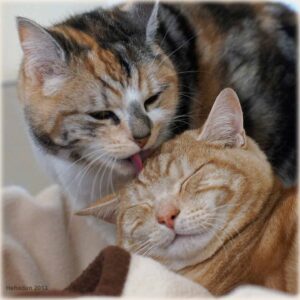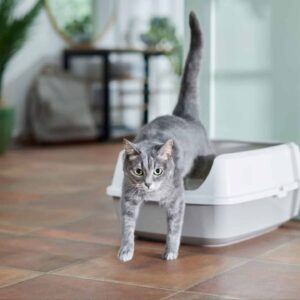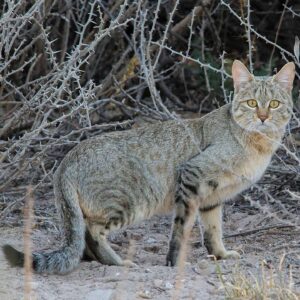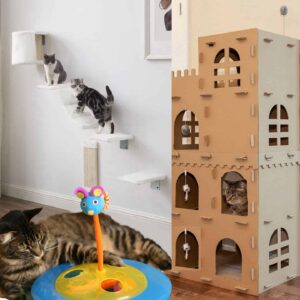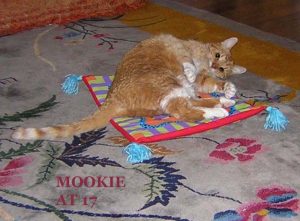Dealing With Aggressive Behavior In Your Cat
Why Does My Cat Bite & Scratch, And What Can I Do About It?
Ron Hines DVM PhD
Some house cats, like some people, are sweethearts. They crave affection, companionship, touch and attention. They are trusting, tolerant and mellow. They come to us with their tails held high to greet us at the door. They rarely show displeasure and when they do, their inclination is to just leave. They don’t hold grudges. I call them sweetheart cats. But there are a few – perhaps 10-15% these days – that remain aloof, timid and even aggressive toward their owners. Most arrived by way of an animal shelter or rescue. Some are feral rehabs. Sometimes the overworked staff were honest about the cat’s personality issues, sometimes they weren’t, and sometimes they didn’t know or just hoped for a good owner-cat match. (read here) This article is about those cats, why they are that way, your options for living with them and why the problem is considerably more common today than it once was.
Aggression And Your Cat’s Genetics
Genetics almost certainly plays a part in a cat’s friendliness. Genetics does in every species – us included. (read here) There were two studies that appear to show how important your cat’s genes were in influencing its friendliness. But both were too poorly designed for their results to be applicable to the general cat population. But you can read them here & here. Another study on why some kittens cry more than others suggested that genetic variations were one of the things that needed to be considered. (read here) Another found a possible link between aggressiveness and fur color. Tortoiseshells, females, orange, calicos, torbies, and gray-and-white cats were reported by their owners to be more aggressive toward them. However, owner-reported studies are the type least likely to be accurate. But if you ask me for Stelow2016, I’ll send you a copy. Genes responsible for agreeableness always accompany the domestication of animals. In the roaming tom cat, the feral, and the homeless cat population, there is no advantage in having them. They are a burden on survival. Your dominant neighborhood Tom remains king of the mountain because of his aggressiveness. (read here) No single gene is responsible for aggression, but studies across the animal kingdom tend to focus on the MAO-A gene which regulates fight or flight hormones as well as the RBFOX1 gene mentioned earlier. Both, and doubtlessly many more genes, have important effects on docility and aggressiveness in domesticated animals. But none specifically examined cats. Remember that none of these genes work independently from your cat’s early life experiences. They are just an open door to a potential problem. One survey of 1,717 cats, found that 16.7% had various states of anxiety and aberrant (abnormal) behavior of which 10.5% were forms of aggression. That is opposed to ~ 1-3% of the human population that has been found with overly aggressive tendencies. A perceptive observer can already see tendencies toward aggression in kittens.
Aggression Issues, Behavioral Issues, Cat Homelessness, Pet Overpopulation, Human Loneliness And Corporate Greed
Cat maladjustment and socialization failures are more common today than they once were. All facets of our society are more tense, why should our cats be the only ones immune to that? In the past, the main source of a new kitten was your neighbor’s in-and-out cat’s unplanned litter, born in an open drawer or under the house. Or the farmer’s barn mousers that recently gave birth. Kittens from both those sources tended to be well-adjusted and easy to socialize. As importantly, most of us were one-cat-families then. The humane movement did not exist to the extent it does today. Animal rescues were few, no-kills were nonexistent. Feline group homes did not exist. Nuclear, multigenerational families gave greater emotional support. So human feelings of loneliness and isolation were less profound then.
Who Is Happy With This Situation?
Well, the greater pet industry, in their never-ending quest for money certainly is. They saturate the internet, and other media with with misleading imagery of perfectly adjusted multi-feline families living together harmoniously without conflicts.
Walt Disney Did Not Understand Cats
Just like today’s mass media, Hollywood has a powerful influence on a child’s sense of reality. Although we don’t like to admit it, many of the thought patterns we learn as children persist throughout our lives. Walt taught us that cats talk, cats think and act just like us. Cats are little people – just in cute furry bodies. Walt Disney was a master animator and storyteller, but he knew nothing about cats. In fact, Walt was not a fan of real cats at all. He was once quoted to have remarked that he “was not crazy about cats”, that he was strictly a dog person. Contrary to the animated Hollywood cats he drew and gave voice to, real house cats are not by nature herd or group animals like dogs or people. Their ancestors were native forest and desert cats whose mothers and kittens lived widely separated from one another to assure them an adequate food supply. After about a year, kittens and their mothers permanently parted ways. Whatever abilities cats have acquired to live in crowded groups and share have only acquired since their domestication. Cats remain intensely territorial. You may not be aware of it, but an invasion of their space by strange or unaccepted felines often causes them immense stress. That stress can be redirected against you. (read here) Cat colonies confront cats with situations Nature never intended them to deal with. (read here & here) Dedicated activists who lead with their emotions do not understand the long-term consequences of feline group homes. Many consider it politically incorrect to even bring up these points. These folks obviously mean well, but they have a tendency to blame you when problems integrating a new cat into your household or gaining the trust of a semi-feral cat arise. One cat may look like another. But some homeless cats and kittens that lacked critical early human association differ from from well-socialized house cats in important but subtle neuropsychological ways. (read here)
Aggression Resulting From A Lack Of Normal Kittenhood Socialization
I mentioned to you how critically important a kitten’s early life experiences are in molding its adult personality. All kittens are born with a brain that is quite “plastic” (moldable) as to how it perceives and adapts to the world around it. What a kitten perceives as family, what it finds enjoyable, what it perceives as a threat or a rival and how it deals with stress are all dependent on its early experiences. The window of opportunity that determines if a kitten will grow up to be a well-adjusted cat opens considerably earlier and closes considerably sooner than most people suppose. Some observers of cats believe that the window opens as early as the kittens first week – even before its eyes open (at 7-10 days). The first signs of sociality in kittens are already well-formed by the time they are 3 weeks old. Others consider the kitten’s first 3–8 weeks as the most critical time to develop lifelong inter-cat and inter-human tranquility. (read here) So it is important that kittens be handled and talked to before their eyes open. That critical sensory learning begins so early in kittens shouldn’t be a surprise. Our infants’ perception of touch begins long before birth. The tactile (touch) of humans needs to be experienced by kittens before vision develops. It is quite possible that cats not experiencing human touch in their infancy might find your stroking and petting objectionable when they become adults. No one really knows. Some have noticed that kittens, unaccustomed to humans, look to their mothers when forming positive attitudes toward people and accept human companionship better when their mother is present and feels the same. (read abstract here) or ask me for Crowell-Davis2004.pdf Others have also noticed that kittens unhandled in their infancy are handicapped in forming close human or inter-cat attachments later in life. (read here) It is also common for homeless cats to wean their kittens too early due to the stress of colony living, starvation, parasites and disease.
Weaned Too Early
Many shelter kittens looking for homes have been weaned too soon (earlier than 12 weeks) in a hast to find them placements. Non-domestic cats in the wild (Felis silvestris) wean their kittens at 3.5 – 4.5 months. Kittens can be forcibly weaned much earlier than 12 weeks, but the psychological effects of doing so are risky. (read here) Premature weaning has psychological penalties for us humans too. (read here & here)
Are You Telling Me I Shouldn’t Give A Problematic Cat A Home?
No.
I do not want to discourage you from taking in one or more of these homeless partially socialized cats or kittens. I just want you to be aware of possible realities when you do so. Many people who take these cats in, do so out of compassion – a jewel in your Heavenly crown.
What Is The Best Sign That My Cats Are Getting Along?
Allogrooming Two cats enjoying each other’s company.
What Are Some Of The Things I Might Try To Minimize Aggression And Other Objectionable Behaviors In My Cat?
Diet
Much of a cat’s attention revolves around the food resources you provide at feeding time. Feeding time is an event when even poorly socialized cats are forced to interact with their housemates and owners. How often you feed your cat(s), what you feed your cat(s) and where you feed them have major influences on your cat’s mood and behavior. Cats are pre-programmed to eat frequent small meals throughout a 24 hr day and to do so in solitude. Regardless of those images cat food manufacturers throw at you, cats are not programmed to consume large infrequent meals in a community setting around a shared food dish. I suggest you use multiple programmable and puzzle feeders located as far as possible from each other. (ask me for Gonzalez2018.pdf) Food aroma and taste affect a cat’s mood at least as much as it affects yours. Experiment with different foods you prepare at home. For example, cooked ground turkey (fortified with calcium and chicken liver) is one of the best sources of tryptophan. Tryptophan is known to improve mood and lessen anxiety. (read here & here) The Royal Canin® Feline Calm given has, as an ingredient, powdered milk (alpha-casozepine) with the lactose sugar removed as well as added tryptophan. I don’t suggest it because cats on dry kibble seldom drink enough water to prevent chronic dehydration. (read here) Canned tuna has considerably more tryptophan per ounce than turkey, but the taste of tuna can be cat addictive.
Litter Box
Another important activity for a cat is marking its territory. Doing so gives your cat(s) a sense of security. Much of those territorial urges center around the litter box – its equivalent to a forest marking tree. Multiple cats in a household are never entirely comfortable sharing a litter box. It is not in their underlying nature to do so. So changes in the location, number, size and type of litter you provide can have positive and negative consequences on your cat’s mood, interactions and feelings of safety throughout the day. Every now and then, topical products are introduced that are said to mellow the mood of cats. Some that are thought to have hormonal calming activity are suggested in or near the litter box. To date, they have met with mixed or contradictory results. You are welcome to give them a try. As I mentioned before, litter boxes and food receptacles need to be kept as distant from each other as possible.
Private Space
Everyone needs a space they can call their own, particularly cats. You might think that cats, being smaller than many dogs, would need less space. The opposite is true. Your cats are all descendants of Lybian wildcats. They began to dwell with humans 9-10,000 years ago, about the time humans began the mass cultivation of grain. (read here) Dogs domesticated much earlier, and being natural pack animals, dogs tend to get on much better in shared space than cats do. But the Lybian cats were extremely territorial. They only associated with each other when looking for mates and both male and female cats fiercely defended their territories against intruding cats. Those individual territories in a male and female desert Arabia were 20 miles (ca. 32 km) and 11 miles (ca. 18 km) respectively, and in 26 of the wild cats of Europe, 39 miles (ca. 63 km)2. You don’t need nearly that space for your multiple cats to remain relaxed. But the least you can do is give them access to their own bedrooms or nooks when they feel the need to be alone. Just as people differ in their need for private space, cats do too. The amount of”Personal” space that provides a cat comfort also changes when life situations change. “Personal” space needs might be the shared space of two cats in a larger group that have bonded and exhibit the Allogrooming I mentioned earlier. Most cats enjoy perching. All enjoy a window sill. A series of perch steps can substitute for square floor footage. When that personal space is for an older cat, ramps make them more accessible. Hiding spaces are appreciated as well. Breed differences exist as well. Some recently developed cat breed, such as bengals and their crosses, savannah cats and chausie cats may be more demanding in their space needs and more prone to inter-cat aggression.
Environmental Enrichment
An indoor life without stimulation and positive distractions is just as boring for your cat as it would be for you. Some cat owner’s remedy for that is to leave a house side door ajar, or an installed in-and-out cat door. I don’t suggest you do either of those things for a great number of reasons. For one, on average, in-and-out cats have considerably shorter lifespans. Multiple diseases, parasites and assorted dangers lurk out there. There are safer ways for you to avoid feline boredom. For another, your cats might not be the only ones using those doors. Altering your cat’s indoor environment to add stimulation and activity options will positively alter its general behavior and mood: A safe places to climb, hide and snooze. Locations of solitude from you and your other cats. Puzzle feeders and toys. Some of the preferred locations offered should be elevated (e.g. cat trees and shelves, claw posts etc.). The internet is full of ideas. Many are likely to reduce a cat’s hostility and stress.
What About Medications To Treat Aggression And Other Personality Issues In My Cat?
I believe that quite a few cat owners, some cat psychologists and even some veterinarians fail to recognize that in cats with behavioral issues, brain anatomy and circuits have physically changed. (read here) Veterinarians like me have no medications that will reverse those changes nor do we have medications that specifically treat aggression. What we do have are drugs that “lower the volume” of response to a variety of stimuli in general. Because of that, none are ideal solutions to feline behavioral problems. I particularly avoid dispensing these medications to cats that attack their owners (caregivers) or other members of your household. I have seen too many cat owners injured by their cats while on medication. They often arrive for other health-related issues, perhaps they suspect that a UTI is causing urine spraying. Perhaps a constipation/anal sac problem or failure to groom in an overweight cat. It is common to be in denial when they arrive at my animal hospital. They might give me excuses for the slashes on their arms. “I woke him up while he/she was sleeping”. “It’s only a small scratch”. “He/she was just having a bad day” “She/he couldn’t help it”. “Underneath, he/she is really a good cat”.
General Sedatives
Benzodiazepines like diazepam (Valium®) and midazolam (Versed®) are known to reduce anxiety (anxiolytic drugs). Their hoped for effect is through the general sedation they produce. Diazepam would be my first choice in medications – after a blood chemistry profile was performed to be sure the drug was likely to be safe for your cat. That is because reverse effects and liver dysfunction were once reported to be a possible side effect of diazepam. Side effects were probably dose and dose frequency related, or were given to cats that had pre-existing liver issues. (read here) Diazepam might be helpful when combined with some of the other household modifications that I mentioned earlier. Perhaps, over time, your cat’s dose could slowly be lowered or days skipped between administration. Diazepam is also an effective appetite stimulant in cats, so watch out for the munchies. We don’t want your cat to become overweight. Diazepam also has a bitter taste. Specialty pharmacies market it as a trans-dermal gel and could probably put it in a tasteless capsules or flavored syrup as well. How effective diazepam is in transdermal form in cats is unknown. In rabbit studies, only 36.25%. of the amount of diazepam in the gel penetrated the skin. Another problem is that all the benzodiazepines are control drugs. Your veterinarian might be hesitant to prescribe them due to the DEA headaches involved.
Antidepressants
Drugs developed to treat depression in humans have also been used to attempt behavioral modification in cats. The most common ones veterinarians dispense to cats today to combat aggression are fluoxetine (Prozac®), buspirone (Buspar®), amitriptyline (Elavil®) and clomipramine (Anafranil®). Possible side effects of these drugs include generalized sedation and disorientation. Buspirone appears to be the most free of unwanted side effects when given to humans. One study found it helpful when urine spaying was the issue. (read here) A study attempting to provide buspirone and amitriptyline as a transdermal ointment found them ineffective. (read here)
Trazodone
Trazodone is another medication primarily sold to treat depression, anxiety and alcohol dependency in people. In humans and cats, it is also a sedative. (read here) Trazodone has been given to people to control aggression. How long-term administration of this drug might affect cats has not been determined.
I rarely recommend any of these medications for long-term use in cats. The first reason is that I find it unsettling to keep any animal “drugged” for convenience. The second is that medicating a cat orally – especially one that is sociologically challenged – is never easy on the cat or on you. With time, your cat will learn to leave when it sees you coming. The third is that the evidence is flimsy that these medications actually work. But if you elect to give any of them a try, I would give the medication a 2-months trial if your cat accepts receiving them without a fuss. That is because you have so few alternative options when non-pharmaceutical options fail.
What About A Cat Psychoanalyst?
Discussing you and your cat’s situation with another empathetic person is always comforting. As with humans, basic cat personalities once established in kittenhood do not readily change. (read here) But that doesn’t mean that they cannot be improved through some of the techniques I mentioned earlier or that your skills in coping with these situations cannot be improved through professional help. If you elect to use one of their services, I suggest the person visit your home in person to get a good feel for you and your cat(s). Every cat-to-human relationship is unique and requires a unique approach. It is not something that can be done by checking boxes on a form, cookie cutter consultations over the internet or by phone. Title and position award no diplomas for empathy. It might turn out that your best psychoanalyst is the doorman at your condo or Aunt Jenny. Cat owners faced with decisions on the fate of an unmanageable cat experience enormous guilt. At the least, giving these people a try lets you assure yourself that you have left no stone unturned. Unlike dogs, it takes cats considerably more time to venture into uncharted waters. (read here)
What About Cats That Develop Aggressiveness Or Other Psychological Issues Later In Life?
Cats of any age can change their attitude and become upset when a non-compatible cat disturbs the feline peck order. However, individual cats that were once human and inter-cat friendly, but loose those attributes might have a different set of issues. It could be due to things you might not have considered. Things such as your cat viewing another cat through a window or smelling the scent of its urine or your clothes. New people in the house, remodeling projects, new odors etc. can make cats uncomfortable too. When you are certain that no such event(s) occurred, your cat needs a veterinary exam to be sure its personality changes are not due to a health issue your cat is facing. Let your veterinarian sort that out. When you have multiple cats, it can be hard to decide which of the cats precipitated the problem. The one that appears most affected may not be the one that caused the issue.
When it is your older cat that no longer appreciates being petted or picked up, that can be due to arthritis pain. There is a new medication, Solensia® that might be helpful. You can read about other traditional options to manage arthritis pain in cats here. Behavioral changes can also be due to one of the many other health issues that older cats face. Hyperthyroidism, so common in older cats, commonly causes hyper-excitability and personality changes. The mental decline of old age (cognitive dysfunction) is said to occasionally result in aggression. But issues such as your cat’s loss of litter box training or confusion are much more common symptoms of the mental decline. Urinary tract pain, such as due to struvite crystals, also cause behavioral changes.
You are on the Vetspace animal health website
Visiting the products that you see displayed on this website help pay the cost of keeping these articles on the Internet.





